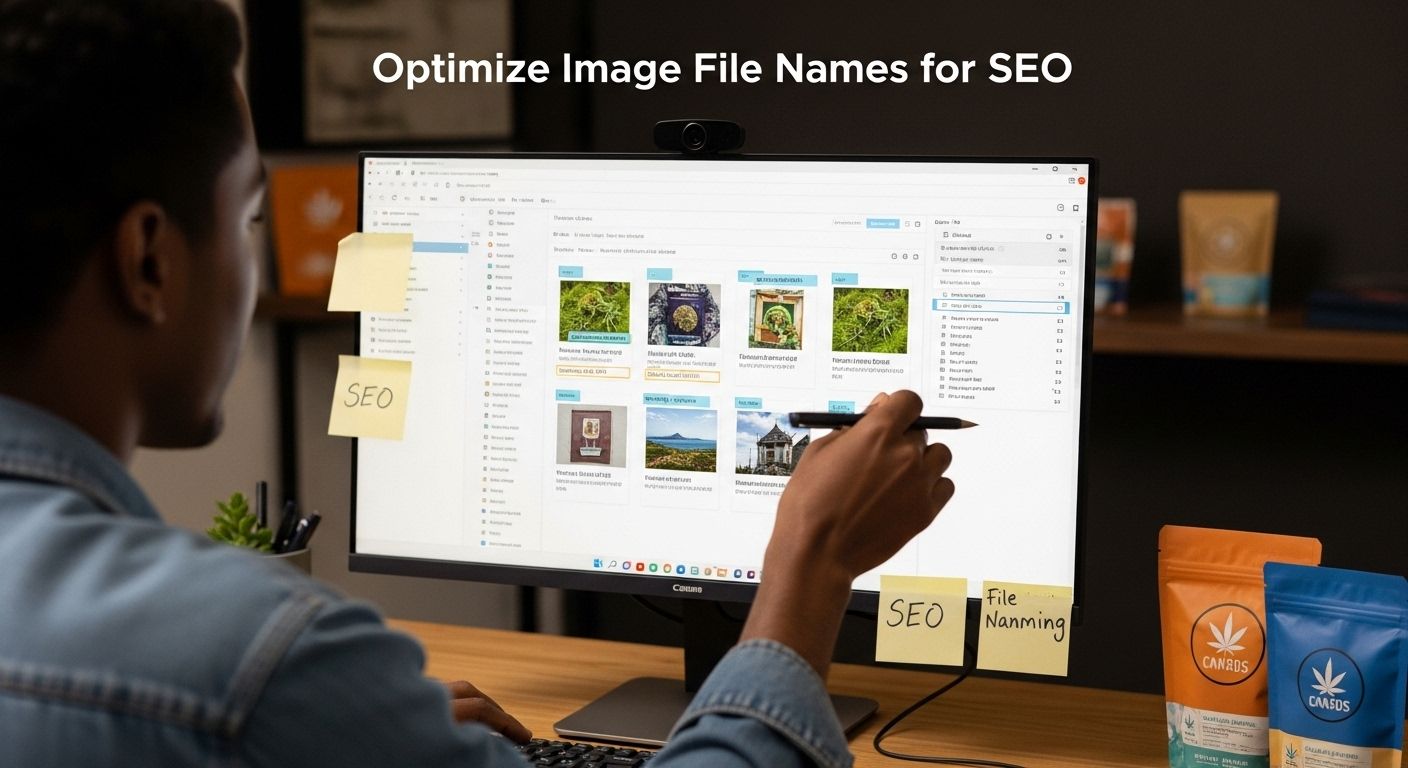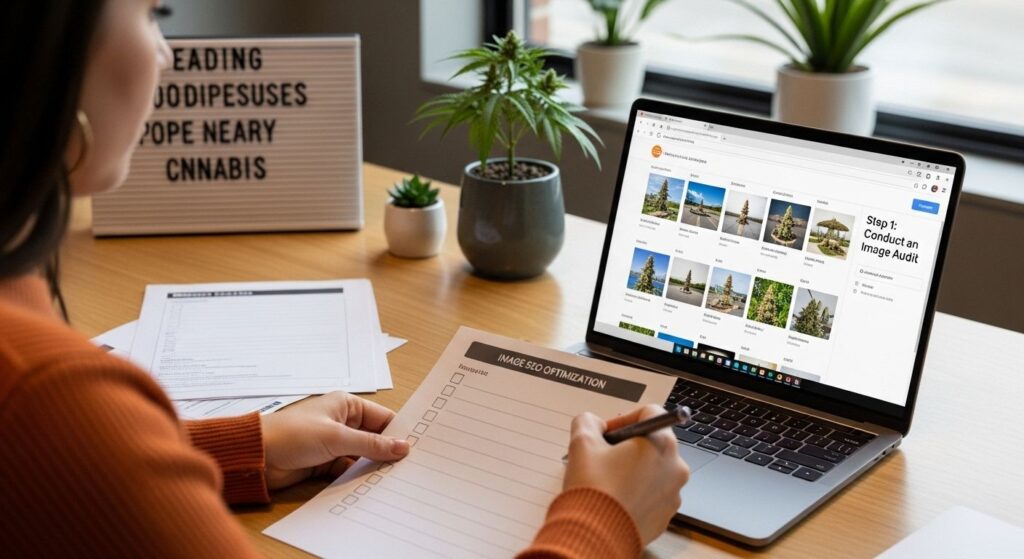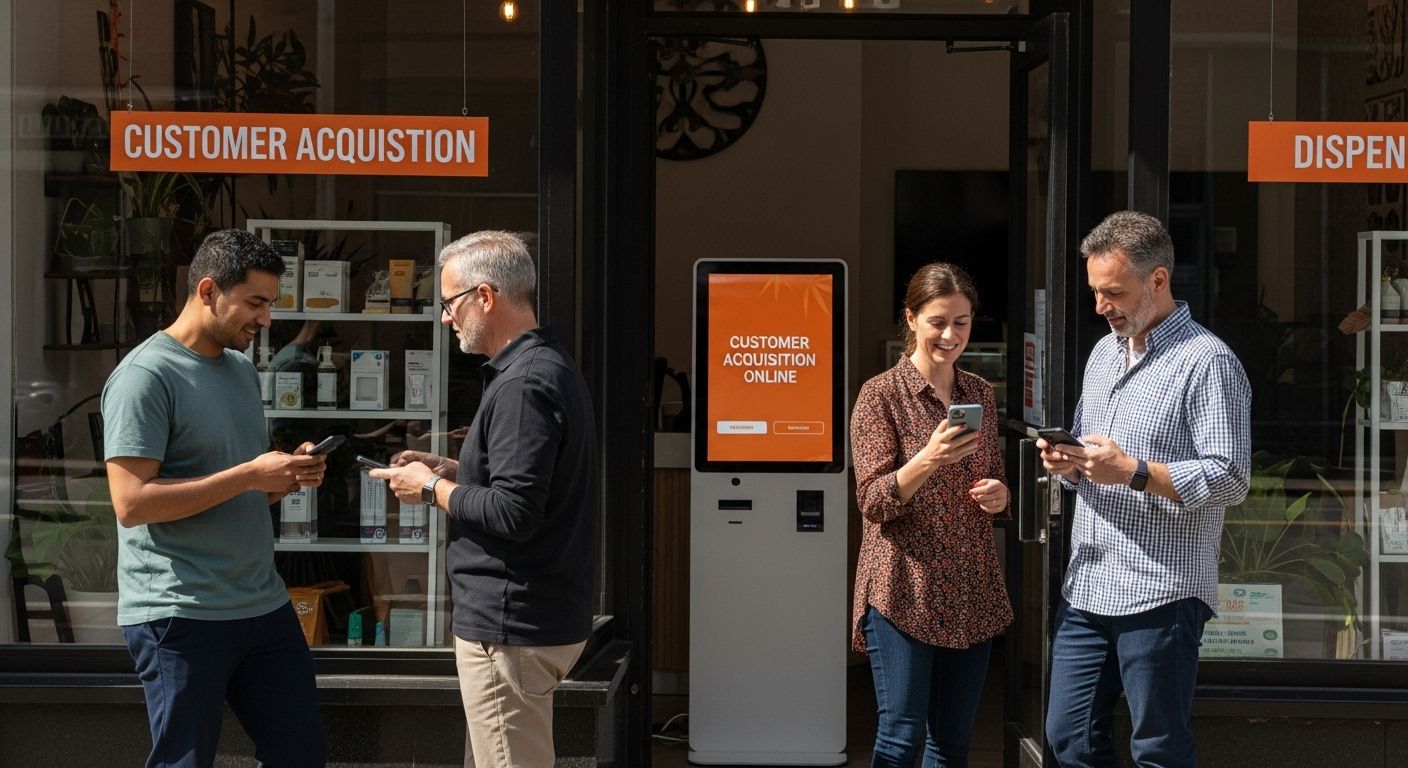Improving your local cannabis store’s online presence often starts with eye-catching images. A single well-optimized photo can be the difference between someone clicking through or moving on. Yet most dispensaries overlook a simple fact — images that are not compressed and properly named can slow your website and cost you rankings, with file sizes over 4000 pixels wide commonly uploaded instead of the recommended 600 pixels. Surprisingly, the biggest SEO gains do not come from flashy graphics. They come from small technical tweaks in your image setup that can instantly lift search visibility and get more customers to your shop.
Table of Contents
- Step 1: Conduct An Image Audit Of Your Website
- Step 2: Optimize Image File Names For Seo
- Step 3: Implement Alt Text For Better Accessibility
- Step 4: Resize And Compress Images For Faster Loading
- Step 5: Test Image Performance With Seo Tools
Quick Summary
| Key Point | Explanation |
|---|---|
| 1. Conduct a thorough image audit | Review every image on your website for optimization potential before making any changes. |
| 2. Optimize image file names for SEO | Use descriptive, keyword-rich filenames to improve search engine recognition and visibility. |
| 3. Implement strategic alt text | Craft concise alt text to enhance accessibility and improve search visibility while accurately describing images. |
| 4. Resize and compress images effectively | Adjust image dimensions and file sizes to improve website loading speed and user experience. |
| 5. Utilize SEO tools to test performance | Run image tests using SEO tools to identify performance issues and quantify improvements post-optimization. |
Step 1: Conduct an Image Audit of Your Website
Starting your image SEO optimization journey requires a comprehensive website image audit. This critical first step reveals hidden opportunities to improve your local cannabis store’s online visibility and search performance. Before implementing advanced image strategies, you need a clear understanding of your current visual content landscape.
Begin by systematically reviewing every image across your website. Open each page and examine images with a critical eye for search optimization potential. Pay special attention to product photos, storefront images, and any visual content representing your cannabis dispensary. Check if images are correctly sized, properly compressed, and include meaningful file names that describe their content accurately.
Utilize tools like Google PageSpeed Insights to assess image performance and identify potential loading issues. These diagnostic tools provide detailed insights into image optimization opportunities, revealing file sizes, format compatibility, and potential compression improvements. Your goal is to create a comprehensive inventory of existing images, noting which ones require immediate optimization.
Key verification criteria for your image audit include:
- Unique, descriptive file names for each image
- Alt text that accurately represents image content
- Appropriate image dimensions matching display requirements
- File sizes under 200KB without significant quality loss
- Consistent image formats (preferably WebP)
As you conduct your audit, learn more about technical website foundations that support comprehensive image optimization strategies. Document your findings meticulously, creating a clear roadmap for subsequent image SEO improvements. Each image represents an opportunity to enhance your local cannabis store’s digital presence and search rankings.
Below is a checklist table summarizing key criteria to verify during your website image audit to ensure all images are SEO-optimized and technically sound.
| Verification Criteria | What to Look For | Example or Benchmark |
|---|---|---|
| Unique, descriptive file names | Each image name clearly describes its content | “organic-cbd-tincture-30ml.jpg” |
| Accurate alt text | Alt text represents image content without keyword stuffing | “modern cannabis dispensary interior” |
| Appropriate image dimensions | Images match their displayed size on the site | 600px width for standard product |
| File size under 200KB | Images remain lightweight for fast loading | 150KB per image |
| Consistent, modern format used | Preferably use WebP format for best performance | .webp extension |

Remember that a thorough image audit sets the foundation for advanced optimization techniques. By systematically reviewing and documenting your current visual assets, you establish a baseline for measuring future improvements in search visibility and user engagement.
Step 2: Optimize Image File Names for SEO
Image file names are silent communicators for search engines, transforming seemingly random digital files into strategic SEO assets for your local cannabis store. While most business owners overlook this critical detail, smart image naming can significantly boost your online visibility and search rankings. The goal is to create descriptive, keyword-rich filenames that tell Google exactly what your image represents.
Start by replacing generic default names like “IMG_1234.jpg” with precise, meaningful descriptions. For a cannabis dispensary, this means using filenames that clearly communicate the image content. Instead of a nondescript file like “photo123.jpg”, rename your storefront image to “downtown-cannabis-dispensary-exterior.jpg” or a product shot to “organic-cbd-tincture-30ml.jpg”. These descriptive names provide immediate context for search engines and potential customers.
Consider the technical nuances of file naming. Use lowercase letters, separate words with hyphens (not underscores), and avoid special characters. Hyphens are preferred because search engines read them as word separators, improving keyword recognition. For example, “blue-dream-cannabis-strain.jpg” is more SEO-friendly than “blue_dream_cannabis_strain.jpg” or “BlueDreamCannabisStrain.jpg”.
Verification checklist for optimized image file names:
- Descriptive and specific to image content
- Contains relevant keywords
- Uses lowercase letters
- Separates words with hyphens
- Avoids special characters
- Under 60 characters in length
Explore advanced SEO optimization techniques to complement your image file naming strategy. Remember that consistent, thoughtful image naming is an ongoing process. Regularly audit and update your image files to maintain optimal SEO performance and ensure your local cannabis store stands out in search results.
This table provides an at-a-glance checklist to help you ensure each image file name on your website meets SEO best practices for increased visibility.
| File Naming Practice | Requirement | Example |
|---|---|---|
| Descriptive and specific | Clearly states what the image shows | “downtown-cannabis-dispensary-exterior” |
| Relevant keywords included | Names incorporate appropriate search terms | “organic-cbd-tincture-30ml” |
| Lowercase letters only | No uppercase letters in name | “blue-dream-cannabis-strain” |
| Hyphens between words | Use hyphens, not underscores or spaces | “storefront-signage-night” |
| No special characters | Do not use !, &, @, etc. | “sunny-day-dispensary-front” |
| Length under 60 characters | Keep file name concise | “hemp-edibles-chocolate-10mg.jpg” |

Step 3: Implement Alt Text for Better Accessibility
Alt text transforms images from visual obstacles into powerful communication tools for search engines and users with accessibility needs. For local cannabis stores, implementing strategic alt text means creating descriptive, context-rich image descriptions that enhance both user experience and search visibility. This step bridges the gap between visual content and comprehensive digital communication.
Craft alt text that provides meaningful context without unnecessary complexity. Think of alt text as a concise verbal description of your image that would help someone understand its content if they cannot see it directly. For a cannabis dispensary, this might mean describing product images, storefront views, or staff photos with precise, informative language. An image of your dispensary’s interior could have alt text like “modern cannabis dispensary with clean display cases and friendly staff assistance”.
Avoid keyword stuffing or creating overly lengthy descriptions. Alt text should be clear, direct, and under 125 characters. Focus on communicating the essential information and purpose of the image. For product images, include key details like strain type, product size, or unique characteristics. A CBD tincture image might use alt text such as “30ml full-spectrum CBD oil with dropper, organic hemp extract”.
Key considerations for effective alt text:
- Describe image content accurately
- Keep descriptions concise
- Provide context relevant to page content
- Avoid redundant phrases like “image of” or “picture of”
- Use natural language
Explore advanced website optimization strategies to complement your accessibility efforts. Effective alt text is more than an SEO tactic; it’s a commitment to inclusive digital communication that welcomes all users to your online cannabis store. By treating each image as an opportunity to communicate clearly, you transform potential barriers into bridges of understanding.
Step 4: Resize and Compress Images for Faster Loading
Image performance directly impacts your local cannabis store’s website speed, user experience, and search rankings. Resizing and compressing images transforms oversized, bulky visual content into lean, efficient digital assets. This critical step ensures your website loads quickly across all devices, keeping potential customers engaged and search engines happy.
Begin by evaluating your current image dimensions. Many cannabis stores inadvertently upload high-resolution product images that far exceed display requirements. A product photo meant to be displayed at 600 pixels wide might be uploaded at 4000 pixels, dramatically increasing file size without adding visual value. Use image editing tools like Adobe Photoshop, GIMP, or online platforms like TinyPNG to resize images precisely to their inte
nded display dimensions.
Compression is the secret weapon for faster website performance. Aim to reduce image file sizes to under 200 kilobytes without sacrificing visual quality. Modern image formats like WebP offer superior compression compared to traditional JPEG and PNG files. Most compression tools allow you to adjust quality settings, finding the sweet spot between image clarity and file size. For cannabis product images, a quality setting between 70-85% typically preserves crisp details while significantly reducing file weight.
Key compression and resizing checklist:
- Match image dimensions to actual display size
- Use modern image formats (WebP preferred)
- Compress images to under 200KB
- Maintain image quality above 70%
- Test loading speed after optimization
Discover comprehensive website optimization strategies to complement your image performance improvements. Remember that image optimization is an ongoing process. Regularly audit and update your visual content to ensure your local cannabis store’s website remains fast, accessible, and search-engine friendly. By treating image files as strategic assets, you create a smoother, more engaging online experience for potential customers.
Step 5: Test Image Performance with SEO Tools
Testing image performance transforms theoretical optimization into measurable results for your local cannabis store’s website. SEO tools serve as diagnostic instruments, revealing hidden performance bottlenecks and opportunities for improvement. By systematically evaluating your visual content, you can uncover precise strategies to enhance search visibility and user experience.
Start with Google PageSpeed Insights, a free and comprehensive tool that provides detailed image performance metrics. Run your website through this analyzer to receive immediate feedback on image-related loading issues. The tool highlights specific images causing slowdowns, recommends compression techniques, and quantifies potential speed improvements. Pay close attention to metrics like Largest Contentful Paint (LCP), which often depends on primary images loading efficiently.
Professional SEO tools offer deeper insights beyond basic performance analysis. Platforms like SEMrush and Ahrefs provide advanced image optimization recommendations, tracking how visual content impacts overall search rankings. These tools can identify images that might be hindering your website’s performance, suggesting precise modifications to improve loading speed and search engine compatibility. For cannabis dispensaries, this means ensuring product images and storefront visuals are not just visually appealing, but technically optimized.
Verification checklist for image performance testing:
- Run website through multiple performance tools
- Check Largest Contentful Paint (LCP) times
- Identify and resolve image-related loading issues
- Compare before and after optimization metrics
- Ensure images meet Core Web Vitals standards
Explore advanced website optimization techniques to complement your image performance improvements. Remember that image optimization is an ongoing process. Regularly testing and refining your visual content ensures your local cannabis store remains competitive in the dynamic digital marketplace. By treating image performance as a strategic priority, you create a faster, more engaging online experience that attracts and retains potential customers.
Take Your Dispensary’s Image SEO to the Next Level with Juiced Digital
Are you struggling to make your cannabis store stand out online, even after following step-by-step image audits and optimization tactics? If you have optimized image file names, compressed product photos, and added alt text but still find your website buried below competitors, you are not alone. Many dispensary owners face frustration when slow site speeds, irrelevant search results, or poorly optimized images keep customers from discovering their stores. Mastering image SEO is just the beginning; winning in today’s digital landscape requires a comprehensive solution tailored for cannabis and e-commerce businesses.
Explore specialized category SEO strategies for dispensaries

Partner with Juiced Digital to achieve more than just basic visibility. Our team delivers specialized digital marketing expertise and proprietary link-building systems designed for regulated industries like cannabis. Do not let your optimized images go unnoticed. Book a strategy call today and unlock measurable ROI, better local rankings, and steady customer growth for your dispensary.
Frequently Asked Questions
How can I improve the SEO of images on my cannabis store website?
To improve image SEO, conduct a comprehensive audit of your existing images. Ensure each image has a unique, descriptive file name, relevant alt text, and is properly sized and compressed for faster loading.
What are the benefits of using alt text for images on my website?
Alt text enhances accessibility for visually impaired users and helps search engines understand the content of your images. Providing clear alt text can improve your website’s visibility in search results.
What are the recommended file formats for images on my cannabis store website?
For optimal performance, use modern file formats like WebP, which offer superior compression and quality. Traditional formats like JPEG and PNG can also be used, but WebP is generally preferred for faster loading times.
How do I ensure my images do not slow down my website?
Resize your images to match the display dimensions and compress them to under 200KB without losing quality. Utilize tools like Google PageSpeed Insights to assess image performance and identify loading issues.
Recommended
- SEO Audit Checklist 2025 for Cannabis and Local Stores – Digital PR Expert | Digital Marketing & Search Leaders
- SEO for Dispensaries: Grow Your Cannabis Business in 2025 – Digital PR Expert | Digital Marketing & Search Leaders
- SEO Content Writing Tips for Cannabis and Local Businesses – Digital PR Expert | Digital Marketing & Search Leaders
- User Experience and SEO for Cannabis Dispensaries in 2025 – Digital PR Expert | Digital Marketing & Search Leaders



